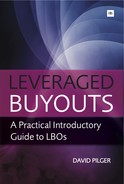0%
23Chapters
0-1Hours read
0kTotal Words
Book Description
Leveraged buyouts (LBOs) are innovative and sometimes controversial transactions. Loading a target company with the debt used to acquire it requires careful judgement, and getting the balance right between debt-load and future performance can be a demanding challenge. The financial analyst's role therefore sits at the heart of a successful leveraged buyout. It is his or her analysis of a target company and a prospective LBO which lays the foundation for a viable deal - or alerts parties to potential problems. This book assists financial analysts by explaining both the principles involved in leveraged buyouts, as well as detailing the ins and outs of putting together an industry-standard LBO analysis. Written by financial expert David Pilger, in lucid and accessible English it takes readers through: - the purpose, advantages, risks and outcomes of LBOs - the typical players in an LBO deal - step-by-step instructions on building an LBO analysis in Excel: from sources of funds, through income statements, cost structure, interest, EBITDA, cash flow, debt paydown and returns Eminently practical and authoritative, this is an indispensable guide for any finance professional or student looking to master a vital area of modern finance. By understanding the techniques and principles underlying LBO analysis, and by working through the model in this book, readers will acquire a deeper understanding of the LBO investor's perspective - and be able to use these techniques as a practitioner in the financial industry.Book Description
Leveraged buyouts (LBOs) are innovative and sometimes controversial transactions. Loading a target company with the debt used to acquire it requires careful judgement, and getting the balance right between debt-load and future performance can be a demanding challenge. The financial analyst's role therefore sits at the heart of a successful leveraged buyout. It is his or her analysis of a target company and a prospective LBO which lays the foundation for a viable deal - or alerts parties to potential problems. This book assists financial analysts by explaining both the principles involved in leveraged buyouts, as well as detailing the ins and outs of putting together an industry-standard LBO analysis. Written by financial expert David Pilger, in lucid and accessible English it takes readers through: - the purpose, advantages, risks and outcomes of LBOs - the typical players in an LBO deal - step-by-step instructions on building an LBO analysis in Excel: from sources of funds, through income statements, cost structure, interest, EBITDA, cash flow, debt paydown and returns Eminently practical and authoritative, this is an indispensable guide for any finance professional or student looking to master a vital area of modern finance. By understanding the techniques and principles underlying LBO analysis, and by working through the model in this book, readers will acquire a deeper understanding of the LBO investor's perspective - and be able to use these techniques as a practitioner in the financial industry.Table of Contents
- Cover
- Publishing details
- About the Author
- Preface
- Part I: Leveraged Buyouts Explained
- Part II: Building and Analysis
- Chapter 5: How Much and Who’s Paying For It?
- Chapter 6: Income Statement
- Chapter 7: Cost Structure
- Chapter 8: Income Statement Forecast
- Chapter 9: Interest
- Chapter 10: Ebitda
- Chapter 11: Cash Flow
- Chapter 12: Outstanding Debt Balance
- Chapter 13: Return Analysis
- Chapter 14: Additional Ratio Analysis
- Chapter 15: Sensitivity Analysis
- Conclusion
- Other Business Books by Harriman House
- Optimising Distressed Loan Books: Practical solutions for dealing with non-performing loans
- Portfolio Representations: A step-by-step guide to representing value, exposure and risk for fixed income, equity, FX and derivatives
- The Operational Risk Handbook: A guide to the new world of performance-oriented operational risk
- The Ultra High Net Worth Banker’s Handbook
- Other Business Books by Harriman House
